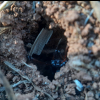So I currently have a small 1 worker C. nearcticus colony. A month or so back, I placed their test tube in a basin with a layer of sand on the bottom. Here are the problems: 1) I decided to dyed their food yellow to see if they eat it, and so far, it looks like neither the worker or the queen have been eating. I've tried giving them different foods, and they won't accept anything, even cricket legs, which they loved before. This is even more surprising because they have 5-6 larvae, which I would assume are very hungry. Whenever I check on them, one of them is standing guard over the brood while the other stays nearby. 2) Their current test tube is very moldy, so I've placed a second test tube with it's opening near the first's. It's been there for a couple weeks and they won't move. They haven't even explored it, or any where outside the tube. I thought Camponotus liked a large foraging area?
Someone please help!


















